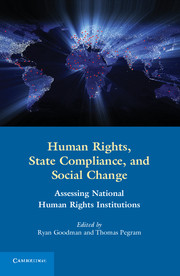Book contents
- Frontmatter
- Contents
- Contributors
- Preface
- 1 Introduction
- PART I NHRIs in Theory and Reality
- 2 National Human Rights Institutions and State Compliance
- 3 The Shifting Boundaries of NHRI Definition in the International System
- 4 Evaluating NHRIs
- PART II NHRI Performance
- PART III NHRIs and Compliance
- PART IV Final Reflections
- Annex 1
- Index
- References
2 - National Human Rights Institutions and State Compliance
from PART I - NHRIs in Theory and Reality
Published online by Cambridge University Press: 05 June 2012
- Frontmatter
- Contents
- Contributors
- Preface
- 1 Introduction
- PART I NHRIs in Theory and Reality
- 2 National Human Rights Institutions and State Compliance
- 3 The Shifting Boundaries of NHRI Definition in the International System
- 4 Evaluating NHRIs
- PART II NHRI Performance
- PART III NHRIs and Compliance
- PART IV Final Reflections
- Annex 1
- Index
- References
Summary
Introduction
One of the purposes of any institution is to routinize compliance with a given set of rules, making it more likely that the rules will be followed regardless of changing circumstances or turnover in leadership. National human rights institutions (NHRIs), most often depicted as a bridge between international norms and local implementation are, in principle, designed to assure the state’s compliance with its international legal obligations. Obviously diverse, NHRIs are charged most often with promoting and protecting international human rights norms domestically. Even if an NHRI does not always advance the state’s compliance, NHRIs – whether through independent activism, cooperation or collusion with the state, or seemingly innocuous promotive work – can alter the human rights landscape domestically. For good or ill, incrementally or dramatically, their incorporation into national human rights struggles cannot be ignored.
NHRIs, then, are not a passing fad. Even when they reflect simple window dressing, or attempts to appease international critics, their existence is still consequential. NHRIs signal the entry of the modern-bureaucratic state into the domestic human rights arena – institutionalizing practices designed to regulate human rights locally. This development is far more crucial than it may seem. Human rights as a field has generally been dominated by nonstate actors, often by activists challenging state practices. States’ actual role vis-à-vis human rights has of course varied widely, including from protector to violator to hypocrite to mediator. Indeed, even the same state can have a highly ambiguous human rights record, respecting some rights but not others or extending rights selectively to certain groups. And while some states have institutionalized human rights in their foreign policies, the state in general has not tended to regulate human rights practices at home. The “regulatory state” has been active in other arenas of governance, but it is a relative newcomer to the business of regulating human rights domestically.
- Type
- Chapter
- Information
- Human Rights, State Compliance, and Social ChangeAssessing National Human Rights Institutions, pp. 29 - 51Publisher: Cambridge University PressPrint publication year: 2011
References
- 2
- Cited by



